This guidance note provides practical advice for claimants when bringing a claim pinqDR’s online platform. It should be read in conjunction with the pinqDR Rules. References to Articles are to Articles of the Rules. Capitalised terms shall have the meanings given to them in the Rules.
1. Who are these guidance notes for?
These notes are intended for claimants who are bringing a claim on pinqDR. Some of the core processes explained are also applicable to respondents but please see the ‘Guidance Notes for Claimants’ for more specific guidance.
Claimants are any representatives of companies that are bringing a claim on pinqDR. This typically includes in-house counsel, management and any external representatives such as external counsel and administrative support.
2. Key principles
| Speed | pinqDR arbitration is subject to strict time limits. The entire process must be concluded within 8 weeks of Commencement |
| Proactivity | pinqDR arbitrators and the parties need to be more proactive than is typical in traditional arbitration procedures. For claimants this is especially relevant when raising the claim. Following the guidance in this guide to ensure a fast acceptance and assessment by the arbitrator will aid the swift and efficient resolution of the dispute. |
| Efficiency | All parties to a claim on pinqDR are not expected to produce long Submissions, communications or formal documents. The pinqDR Rules also remove many traditional procedural processes that enable or even encourage delay and further conflict. Parties must focus on the issues to be determined and responding to the arbitrators requests as quickly as possible. |
3. Overall process
The end-to-end arbitration process on pinqDR is designed to be completed in 6-8 weeks, from the point the claim is accepted by pinqDR and the fee is paid. The timeline below illustrates the process.
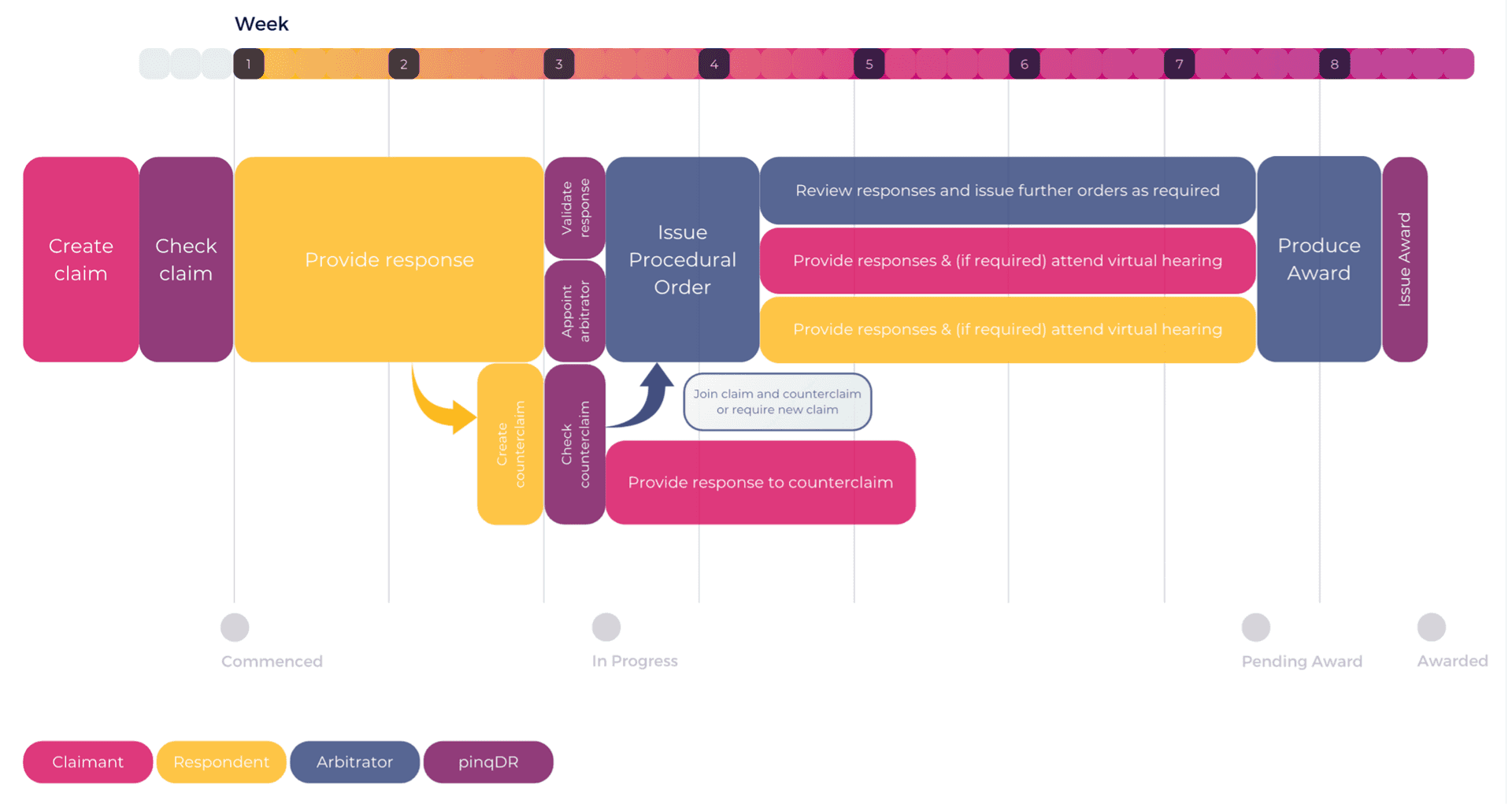
The arbitrator may provide short extensions to any time period of up to 48 hours. Whilst there may be exceptional circumstances requiring greater adjustment to the timetable, pinqDR’s prior approval to any other extension is required.
Each party to a claim on pinqDR has a Primary Representative. This is the person (user) who brings the claim, and this can be changed after the claim has been created. Other representatives can be added during the claim creation process or at any time through the lifetime of the claim.
The outcome of a claim on pinqDR is an Arbitral Award. This is a binding award which is enforceable in any member states of the New York Arbitration Convention.
4. Create Account
In order to start a claim on pinqDR a user account is required. Users can sign up at any time, even if they do not have a claim. On the pinqDR website select “Start Claim” or click this link.

Next you can choose to sign up with email and password, or via a Google or Microsoft logins.
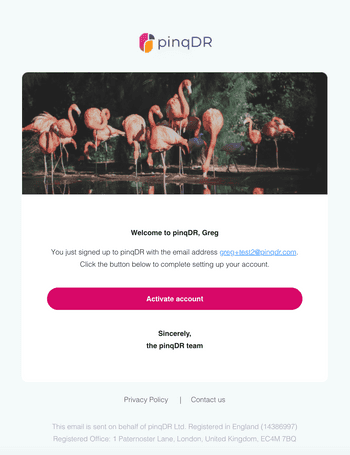
Email and Password Sign-Up
For email and password sign-up:
- Enter the details requested
- Complete the “I’m not a robot” reCAPTCHA.
- Check the box to confirm you have read and agree to the Terms and Conditions and
- Select “Sign Up”. You will then receive an email to activate your account.
- Select “Activate account” on the email and you will be sent back to the pinqDR site
- Log-in with your email and password
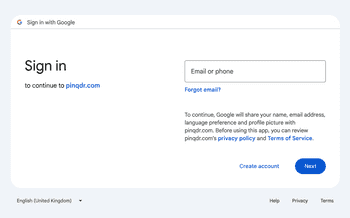
Google Sign Up
To use the Google Sign Up option:
- Select “Sign Up with Google”
- Follow the Google instructions to connect your Google account with pinqDR
Microsoft Sign Up
To use the Microsoft Sign Up option:
- Select “Sign Up with Microsoft”
- Follow the Google instructions to connect your Microsoft account with pinqDR
5. Raise a claim
Starting a claim on pinqDR is done from a number of places.
- When a user first registers they are taken directly to the first stage of creating a claim
- In the left side bar of all screens the “+” icon will initiate a new claim
- On the claims dashboard the “Create New Claim” will initiate a new claim
The process to start a claim is split into 8 simple sections. The progress bar shown throughout the process indicates the stage and it is possible to move back through the stages at any time.

On each section there are two forms of help and guidance. On the right-hand side of the page are guidance notes and tips. Fields shown with an have additional help, select the to show and hide this tooltip.
Details on each stage follow.
Claimant
The first section to complete for a new claim is the claimant details. This is the details of the company that is bringing the claim. Claimants can be from any country that is a contracting state of the New York Arbitration Convention.
The details entered should match those shown in the claimant’s supporting documents, such as contracts and party agreements. Should the claim being brought on behalf of a group company then proof of the association between the companies and validity of raising the claim from the claimant entered should be provided with the claim.
pinqDR’s administrators will verify the information provided on the claimant by cross referencing with documents provided, searches on local company registers and through appropriate KYC and AML tools, prior to a claim being accepted. Should this raise any questions the team will contact the claimant’s primary representative for further information.
Finally, a Tax ID should be provided where available. This will ensure that VAT, or local equivalent, is applied to the pinqDR fee correctly.
Where a claim has previously been raised on pinqDR by the user creating a new claim, that company will be available on the ‘Select Company’ tab within the Claimant section. This is helpful particularly for group companies and external counsel who represent multiple clients.
Once the information on a new claimant has been entered, or an existing claimant company
Representatives
A claimant on pinqDR can have one or more Representatives per claim, which are added to the claim either during its creation (in this section) or later after the claim has been submitted.
Representatives added can have a read-only role, where they can only observe the claim, or an Editor role where they can contribute both to the claim creation and throughout the process.
To add a representative at this stage, enter the person’s first and last names, email address and the role you require them to take. Once submitted an invitation to join the claim will be sent to the representative’s email address and they will follow a link to register and join the claim.

Their name will now be shown on the list of representatives as ‘Invited’ and further representatives can be added in turn.
For more information on managing representatives see the Representatives section of this guide.
Select ‘Next’ to continue to the Respondent section.
Respondent
The next stage is to provide the details of the respondent. This is the details of the company that the claim is being made against. Respondents can be from any country that is a contracting state of the New York Arbitration Convention.
The details entered should match those shown in supporting documents, such as contracts and party agreements.
The primary representative of the respondent is provided here. This person should be known to be able to represent the responding company and to be an up-to-date contact. Provide their email address, first and last names. Once the claim is approved by pinqDR it is this person who will receive the invite to join the claim and provide a response. Please note that until a claim is checked and approved by pinqDR the Respondent will not be contacted.
When a respondent joins the claim, they can update the respondent company details and primary representative, as well as add other representatives.
pinqDR’s administrators will verify the information provided by cross referencing with documents provided, searches on local company registers and through appropriate KYC and AML tools, prior to a claim being accepted. Should this raise any questions the team will contact the claimant’s primary representative for further information.
Select ‘Next’ to continue to the Claim summary.
Claim summary.
The claim summary captures the high-level details of the claimant’s claim.
pinqDR supports claims in USD, EUR and GBP currencies, and claim values between £5,000 and £2,000,000 GBP (or equivalent). Claims over £2m are supported but please contact us before submitting a claim.
Claim values should cover the entire value of the claim save for costs. The pinqDR fee will be added to the claim costs at the arbitrator’s discretion, and further costs can be requested by both parties later in the process.
The claim summary is a short description of the claim. It is limited to 250 characters (about 50 words) so is quite short. A very high-level overview of the basis of the claim is helpful for the respondent, arbitrator and administrators to quickly understand the issue. This summary is also shown on the main overview of the claim.
Once complete select ‘Next’ to continue to the Claim details.
Claim details.
In the Claim details section, full details of the claim are provided. There are two functions in this section:
- A text input box where formatted text can be added.
- A document upload and list
Documents
It is advised the claimants provide as much context and documentary evidence to support their claim as possible. Uploading all relevant contracts, invoices, communication with the respondent will help the arbitrator understand the claim and minimise the need for formal orders from the arbitrator to provide supporting evidence.
Further, it is advised, to provide concise reference to specific elements of documents uploaded to guide the arbitrator to the correct parts quickly. For example, a specific clause in a contract, page within an email exchange, etc.
To reference documents within the claim submission text use the document reference (eg [CT01]).
Finally, keep document uploads as concise as possible. The nature of the pinqDR process discourages long and drawn-out document exchanges. Only provide documents to support the claim and direct the arbitrator to the most relevant aspects of those documents that support the arguments presented in the claim submission.
To upload documents select the “Add Document” button on the right side of the Claim Details section. An upload form will then show.
To upload a file either drag the file onto the upload area or select ‘Upload a file’ to select it from your computer.
Select the File Type from the dropdown list. The main options here are:
- ‘Contract’ - For all contractual documents related to the claim.
- ‘Evidence’ - For all supporting documents.
- ‘Request’ – Documents supporting a request to the arbitrator – such as a request for costs.
- ‘Response to arbitrator request’ – This is not required at the creation of the claim, but later in the process the Arbitrator may make requests for certain documents.
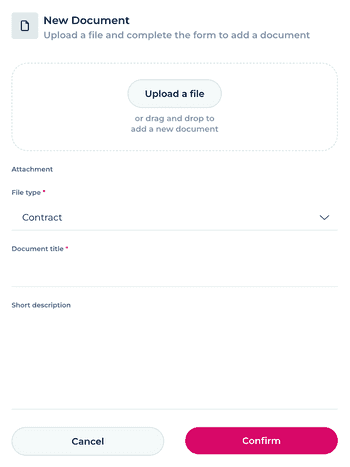
Add a Document Title. This is a short title to reference the contents of the file. This title is shown in various places in the pinqDR platform and is useful for quick reference.
Add an optional Short Description. This is used in the documents list in pinqDR to provide more detail on the document and can be used to highlight references within the document or to provide more context to its purpose.
Select ‘Confirm’ to add the document. The document will then be allocated a reference number and shown in the documents list on the right side of this section. Reference numbers are in the form [XX00] with XX denoting the file type (eg CT for Contract) and the 00 is a sequential number.
The reference number can then be used in the Claim Detail text to guide the respondent and arbitrator to the relevant documents as required.
Documents shown in the documents list can be accessed by selecting the document title and can be removed by selected the ‘trashcan’ icon next to it.
File types supported: pdf, doc, docx, xls, xlsx, png, jpg, jpeg, mov, mp4
Maximum file size: 25Mb
Claim details text
The text box in this section is where the main details of the submission are entered. There is full formatting available and content can be pasted in from other editors such as Microsoft Word or Google Docs.
Please note it is not permitted for a submission to be made in a document which is then attached to the claim in pinqDR. The submission detail must be entered in this section.
As with all guidance for a claim in pinqDR it is advised to keep the submission brief and to the point. It is recommended to add the main points of the claim first and then provide detail on each point. Ensure that any claims are backed up with supporting evidence, documents were applicable, and any supporting documents are referenced within the submission text. Extremely long submissions may be challenged by pinqDR administrators and lead to a claim being rejected.
The simple menu bar at the top of the input box contains various formatting options. From left to right:
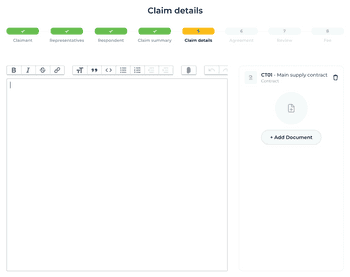
- Bold
- Italic
- Strikethrough
- Hyperlink (highlight the required text to add a link to, then select the link button to add a URL)
- Heading – there is a single heading style available
- Quotes
- Code (fixed width formatting)
- Bulleted list
- Numbered list/paragraphs
- TAB left
- TAB right
- Attach (this is to be used for embedding images within the submission, not for supporting documents)
- Undo last action
- Redo last action
Numbered paragraphs are advised to enable the arbitrator to easily reference their questions and orders. The formatting of numbered paragraphs is in the format 1.1.1.1 etc and cannot be changed. Use the TAB buttons or key on the keyboard to move to the level of numbers.
Similarly, there is a single bulleted list format which can be ‘tabbed’ to different levels.
Other standard formatting options include bold, italic, strikethrough, heading and quotes. Hyperlinks can also be added.
Once complete select ‘Next’ to continue to the Agreement section.
Agreement
In order to user pinqDR and achieve a binding decision, both parties must have agreed to be bound by pinqDR’s Rules of Arbitration. This can be done in two ways:
- Pre-existing contract clause. For more information on contract clauses see the pinqDR Contract Clauses section of the website.
- A Submission (Party) Agreement: Where parties have not agreed to pinqDR at the time of entering into a contract, but subsequently wish to use the procedure for resolution of disputes, they will need to enter into a separate Party Agreement. pinqDR’s standard Party Agreement template is available here.
In this section, confirmation of an agreement to use pinqDR is required. This is in the form of a selection (Yes or No).
If an agreement is not in place, select ‘No’ and follow the instructions to complete a Part Agreement with the Respondent. The position in the claim creation is saved and can be returned to when the Party Agreement is in place.
If an agreement is in place, select ‘Yes’. It is then required to provide proof of that agreement. Select ‘Add Document’ and an upload form will then show. Upload the supporting file (contract or party agreement) by dragging it onto the upload box, or by selecting ‘Upload a file’ and selecting it from your file explorer.
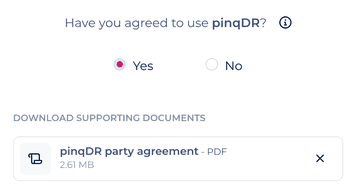
File type: Select whether the document provided is a contract or party agreement and add a title for it below. A short description is optional but could be used to highlight any particular points of interest, such as the paragraph number of the dispute resolution clause in a contract.
Select ‘Confirm’
The uploaded document is then shown and can be removed by selecting the ‘x’ next to it. One file must be provided to continue.
When confirmation of an agreement to use pinqDR has been provided select ‘Next’ to continue to the Review section.
Review
The review section shows all information entered over the previous pages in one place. This enables a full check of information provided prior to submitting the claim. Should anything require changing use the ‘Back’ and ‘Next’ buttons to navigate back through the section, edit as require, and return to the review.
When ready, select ‘Next’ to continue to the final section, the Fee.
Fee
The fee is shown in this section. This is the fee due to start the claim. It is a single case fee including the cost of the arbitrator and there are no further standard fees to pay throughout the claim. The fee may be apportioned in whole or part as part of the final award and is non-refundable. For more information on pinqDR pricing see the Pricing Calculator and the Schedule of Fees.
Further fees may be due for certain activities, such as amending a claim value or raising a Challenge. If pinqDR reject or are unable to accept the claim, then the claim will be refunded less an administration fee set out in the Schedule of Fees.
Under the ‘Type of Payment’ the available payment methods are shown. Bank Transfer is available in all countries. Credit card payments are also available in some countries.
For Bank Transfer payment, pinqDR’s account details are shown including a specific reference for the payment. Ensure that this reference is provided in the payment to enable the payment to be matched to the claim.
Select the confirmation checkbox to confirm that the payment has been made and select ‘Next’ to complete the claim submission.
For Credit Card payments, where available, complete the form shown to submit payments. Credit Card payments are processed through our payment provider, Stripe. Once Stripe confirms the payment then the screen will automatically move to the final confirmation page.
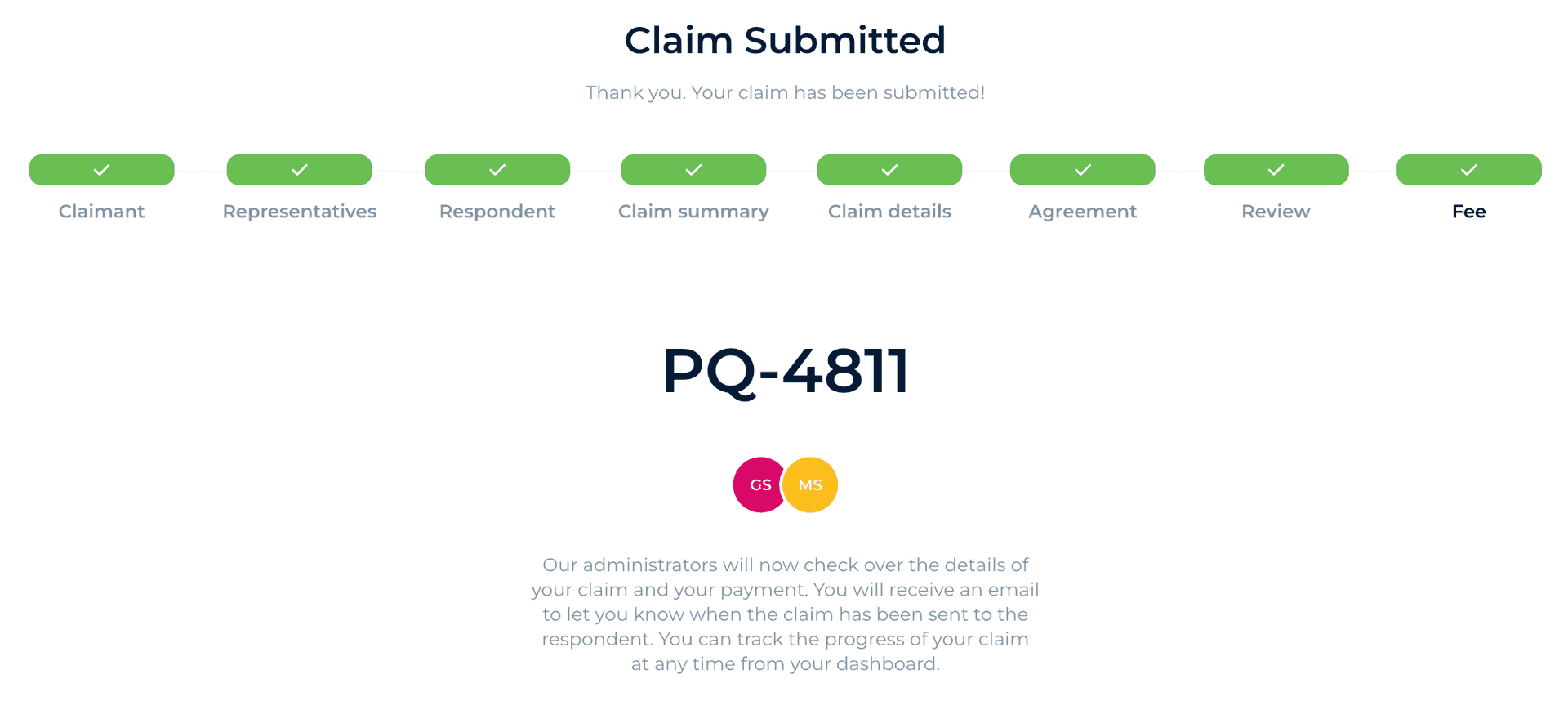
At this point, the pinqDR administrators will be notified of a new claim and will begin the review process. An email confirmation of the claim will be sent to all claimant representatives that have joined the claim.
Each claim is assigned a unique claim number in the form PQ-9999 with the number being randomly allocated to each claim.
6. Claim review and approval
Following a new claim being submitted on pinqDR the pinqDR administrators will begin the review process. This consists of several checks and confirmations to ensure the claim is legitimate, suitable for pinqDR’s process and able to continue.
During this process the administrators may contact the primary representative of the claimant with any questions. Look out for emails from hello@pinqdr.com.
The main checks carried out include:
- Anti Money Laundering (AML)
- Know Your Customer (KYC)
- Conflicts
- pinqDR Agreement (clause or Party Agreement)
- Payment
Once all checks are satisfied the administrators will move the claim onto the next stage. At this point all claimant representatives will be notified and the primary representative of the respondent will receive an email from pinqDR inviting them to join the claim and provide their response.
It is advised, if possible, for the claimant to independently notify the respondent that a claim has been raised and to check their email for the invite. If the email address provided has issues receiving the email invite, please contact the pinqDR administrators for assistance.
The email address provided for the respondent does not need to be the email address that signs up to pinqDR as the primary representative of the respondent. When the respondent follows the link in the email they can register with a different name and email address.
The pinqDR administrators have 3 working days to complete the review. However, should there be any issues to resolve at this stage then this time can be extended. Once the claim is approved the clock starts and the 6-8 week time frame to a decision begins.
7. Respondent response
The next stage is for the respondent to provide their response. From the point that the claim is accepted, and the respondent is notified, they have up to 10 working days to provide the response.
During this step there will be no requirements on, or updates to the claimant.
Once the respondent submits the response the pinqDR administrators will check and verify the response before approving it. On approval, the claimant will receive a notification via email that the response is available in the pinqDR platform.
The response can be accessed on the Response section of the claim. See the “pinqDR Dashboard” section of this guide for more information.
At this time the respondent may bring a counterclaim by means of starting a new claim and referencing its connection to the original claim. In this case, before the respondent’s claim is approved, the arbitrator to the claim will decide if the counterclaim can be linked to, and managed alongside, the initial claim or heard separately. The claimant will be informed of any claim by the respondent after the arbitrator is assigned.
8. Arbitrator assignment
The process of assigning an arbitrator to the claim begins following the claim being approved by pinqDR. However, the arbitrator is not assigned to the claim until the response has been received and approved. A single arbitrator is assigned to claims on pinqDR, panels of arbitrators are not used.
Arbitrators are assigned from the pinqDR roster of arbitrators but may also be sourced outside of this list should specific experience or characteristics be required. Examples of arbitrators can been seen on the Arbitrators page of the pinqDR website. Arbitrators are selected by pinqDR which means that the parties cannot request a specific arbitrator or provide a list of arbitrators. pinqDR’s roster of arbitrators includes some of the most eminent and experienced arbitrators available globally, covering many sectors and types of disputes.
The arbitrator is selected based on their experience in matters specific to the claim, jurisdiction and language. Once the pinqDR administrators identify several arbitrators that would be appropriate for the claim, they are contacted and must confirm that there are no conflicts, and they have sufficient availability to be considered for the claim.
An arbitrator will be assigned to the claim within 2 working days of the Response being approved and both parties will be informed at the same time through a notification.
9. Claim process
Following assignment, the process is arbitrator led which means that all actions and requirements on the parties are set by the arbitrator.
The arbitrator has two mechanisms available to them to communicate with the parties:
- Messaging – a simple messaging system within the claim. The arbitrator controls this service and must enable it to start messaging if they deem it required.
- Procedural Orders – a more formal process where a procedural order document is uploaded to the claim containing specific requests on the parties with any further detail and time requirements.
For example, a Procedural Order may contain an arbitrators requirement for a short online hearing to cover a specific point, then messaging used to coordinate the date and time for that session.
The arbitrator has 5 working days to submit their first procedural order or to inform the parties that no further information is required. Following this there is a period of 16 working days for the parties and arbitrator to work together to answers the arbitrators requests and, if required, hold a short hearing. This period also allows for parties to submit requests for costs to be determined by the arbitrator.
At any point during this stage the arbitrator becomes satisfied that they are able to produce a decision on the claim they can move the claim onto the next stage.
10. Hearings
The vast majority of pinqDR arbitrations will be conducted by documents only. However, there is a power for the arbitrator to call for oral evidence or submissions to be heard in the form of short, online hearings.
For more information on the arbitrators requirements for hearings see section 7 of theGuidance for Arbitrators.
11. Award
When the arbitrator is satisfied that all information required to make a decision has been provided they will move the claim into an Award Pending State. Both parties are notified that the arbitrator is preparing the award and the claim is now locked.
No further documents can be added to the claim by the parties, and no further messaging can occur. The arbitrator has up to the end of the 8 week time limit to produce the award from this point, but speed is encouraged to bring the claim to a close as quickly as possible. Following this the pinqDR administrators will check the award and make it available to the parties. All representatives of both parties will be notified of the award once it is released.
The award consists of a declaration to which party is to be awarded, it can also show that both parties are due some form of award. It also defines the monetary amount to be paid to the successful party. A short summary of the award will also explain any other elements of the award that are detailed fully in the Award itself. These elements are shown in the Award section of the claim.
The formal award document is uploaded to the claim and available to download from the Award section. This document contains the formal procedural history, reasoning and detail behind the award as well as any further requirements on the parties (such as nonmonetary instruction).
Arbitral Awards can only be challenged on a restricted number of grounds. Should a party believe that an award produced on pinqDR should be challenged then they should contact the pinqDR administrators to raise such challenge. Please see Article 8 of the pinqDR Rules.
12. pinqDR Platform Features
pinqDR Claim Dashboard
A claim on pinqDR is managed entirely online through a web based platform accessed athttps://app.pinqdr.com. Each claim is assigned a unique claim number in the form PQ- 9999 with the number being randomly allocated to each claim.
In this section of the guide we will explain the Claim Dashboard:
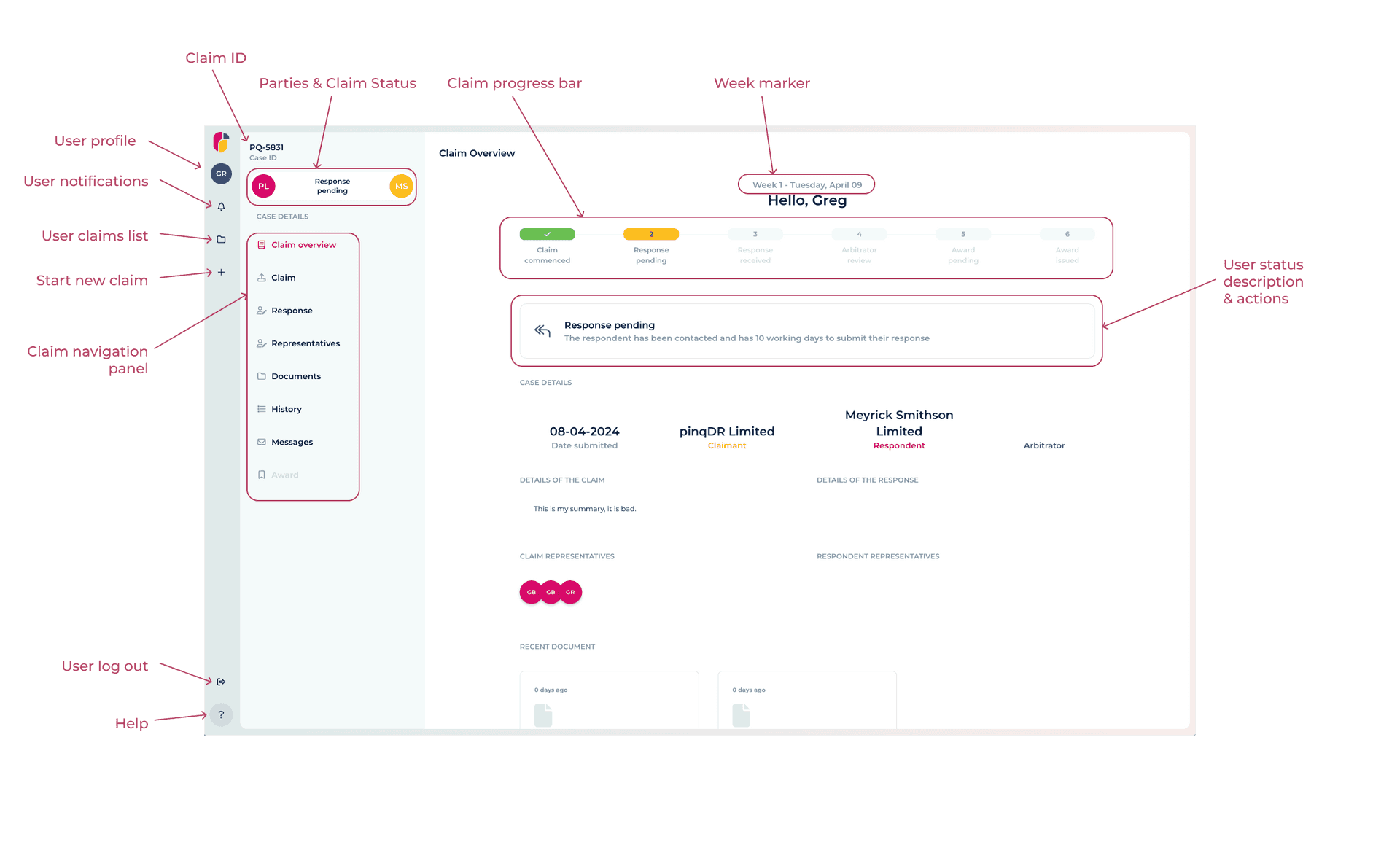
The Claim Dashboard contains all information about the claim. It is the same for both the claimant and respondent. The arbitrator has a very similar view (all claim information is the same for example) with some additional features specific to managing the claim.
A theme throughout the pinqDR platform is colours. Parties and representatives of them are represented by the following colours:
The menu bar on the left side of the dashboard contains elements of the platform that are specific to the user, not the claim. See User Menu below.
The Claim Dashboard has two main sections; the Claim Menu and Claim Window.
Claim Menu
This section is on the left side of the dashboard and allows navigation of the Claim Sections. It has a light-coloured background and is always visible. This menu contains:
- Claim ID: At the top of this menu is the Claim ID - the unique reference number allocated to the claim when it is created.
- Parties & claim status: Icons representing the parties in the claim which show either the first letters of the first two words in the company name, or the logo of the company if provided. Between the party icons is the current status of the claim.
- Claim navigation panel: A list of sections of the claim. Each section is selectable and the active section is shown in colour. If a section is unavailable it is shown in a light grey.
Claim Window
The Claim window contains the content and functions of the section selected in the Claim navigation panel. Below is a detailed explanation of each section.
Claim Overview
The Claim Overview is the first section shown when a claim is opened. It contains the main aspects of a claim for quick reference of its current stage, actions required and summaries.
At the top of the Claim Overview is the current week of the claim, and the current date.
The Claim Progress Bar (as shown in Fig2) shows the end to end process for the claim. There are 6 main statuses of a claim. As each status is completed it is shown in green with a tick. The current state is shown in yellow.
Below the Claim Progress Bar is the Status Description & Actions box. The text in this box is unique to the user and stage of the claim. It contains a clear description of what is happening now as well as any actions that are required by the user.
Following this are four sections showing:
- Claim details – high level details of the creation, parties and arbitrator
- Summaries – the Claim and Response summaries.
- Representatives – icons showing the representatives of each party.
- Recent documents – the most recent three documents added to the claim. The documents can be selected to view.
Claim
The Claim section shows all detail of the claim as provided by the claimant during case creation. This includes full details of the claimant, the summary of the claim, the full detailed claim submission, a list of claimant representatives and a table of all documents uploaded to support the claim.
Response
The Response section shows all detail of the response once it has been provided by the respondent. Prior to a response being submitted and accepted only the respondent details added by the claimant at case creation are shown here. Once the response is provided this section shows all information in the same format and presentation as in the Claim section, but for the response.
Representatives
The Representatives section shows a full list of representatives for both the claimant and respondent. Where a user is a Primary Representative or an Editor there is the ability to both edit the roles of other representatives for their party, and to add new representatives.
For the other parties representatives users are only shown the list of names and roles.
To add a representative complete the New Representative form. Provide the first and last names and the email address of the person required. Finally select the role from:
- Read Only – can only view the claim and not contribute in any way
- Editor – has full access to the claim and can upload documents, support with the submission and send messages.

The list of representatives shown under the claimant representatives includes all users who have been associated with the claimant company in previous claims. No users are added to the open claim without express action by the primary representative or another editor user.
To add an existing known user as a representative the primary representative or an editor can change the user’s role from “None” to either “Read Only” or “Editor”.
When a new representative is added by either of these methods they will receive an invite to join the claim by email. They must follow the link in the email and log in (or create an account) to join the claim.
A newly invited representative, who has not accepted the invite yet will be shown in the list as “Invited”:

Once the invite has been confirmed that representative will be shown as “Joined”

To remove a representative from the claim a primary representative or editor can change he role to “None”. This will then be shown as “Saved” and this user will no longer have access to the claim.

Documents
The Documents section contains a consolidated list of all documents uploaded to the claim by both parties, the arbitrator and the pinqDR administrators. Documents can be viewed and downloaded from this list by selecting the button.
Users with Primary or Editor roles can also upload documents from this section using the ‘Upload Document’ button on the top right of the page. This is required when answering questions and orders from the arbitrator in the course of the claim.
For each document the elements shown are:
- Document reference (XX00) – a unique reference for the document.
- Party – beneath the document reference the party the document belongs to is shown. This can be the claimant, respondent or pinqDR.
- Title – the document title set by the user who uploaded it.
- Uploaded by –the user who uploaded the document
- Type – The file type of the document
- Size – the file size of the document
- Upload date – the date (dd-mm-yyyy) of when the document was uploaded
File types supported: pdf, doc, docx, xls, xlsx, png, jpg, jpeg, mov, mp4
Maximum file size: 25Mb
Messages
The Messages section contains a simple messaging system where the arbitrator and parties can exchange messages about the claim
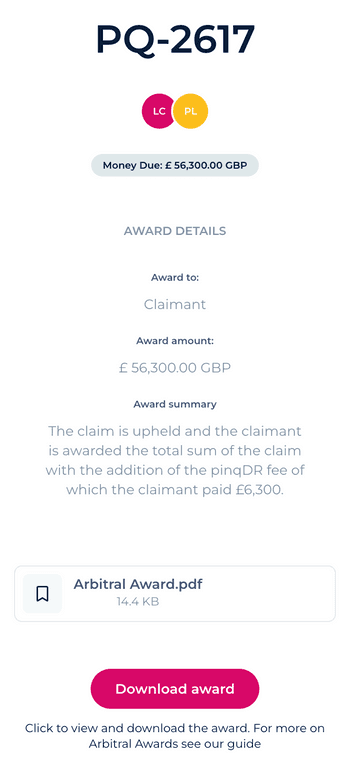
Award
Prior to the award being issued by the arbitrator the Award section is not available and the menu item is therefore greyed.
After an award is issued to the claim, this section becomes available. It contains the high-level information on the award and the formal award document is available to download.
Records of viewing and downloading the award are tracked and shown in the History section.
History
The History section contains a chronological history of all key events and interactions with the claim by all users. This view is the same for any user who has access to the claim. This list is read only.
User Menu
The User Menu contains:
- User profile – select to access the user’s profile with options to edit and change password.
- User notifications – select to view all notifications relevant to the user, across all claims that are in progress. When there is an unread notification a small red dot will appear on this menu icon.
- User claims list – select to access a list of all claims that the user is a representative of, including all historical and draft claims
- Start new claim – select to start a new claim.
- User log out – select to log out of pinqDR
- Help – select to access help resources.
pinqDR – Arbitrator Guidance Note
V1.0, November 2023